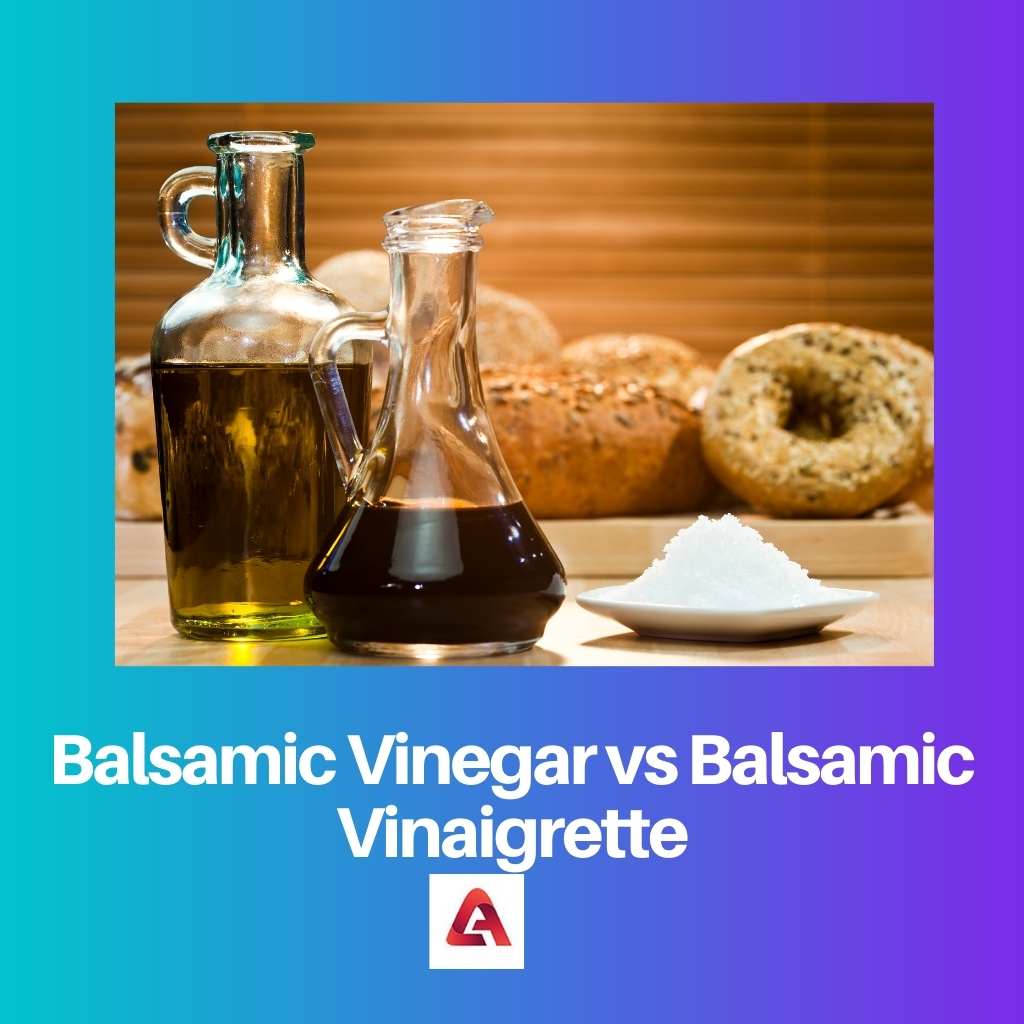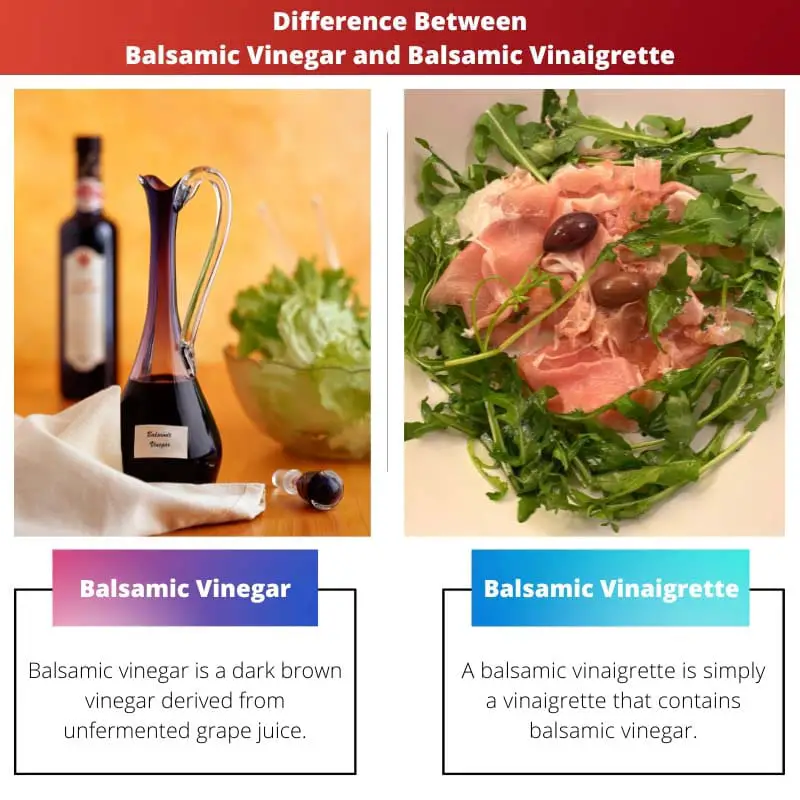Balsamic vinegar and balsamic vinaigrette are two very separate things. While they are both created in the same way, what happens to them after that is what distinguishes them.
More ingredients are added to balsamic vinaigrette than to balsamic vinegar. Each vinegar has its distinct texture and flavor.
Key Takeaways
- Balsamic vinegar is a dark, concentrated, and tangy liquid made from grape must; balsamic vinaigrette is a salad dressing that contains balsamic vinegar, oil, and various seasonings.
- Balsamic vinegar aged longer, while balsamic vinaigrette has a shorter shelf life.
- Balsamic vinegar can be used in cooking or as a finishing touch to dishes, while balsamic vinaigrette is primarily used as a salad dressing or marinade.
Balsamic Vinegar vs Balsamic Vinaigrette
Balsamic vinegar is a dark, concentrated vinegar made from grapes that are cooked down and aged in wooden barrels. They are thicker and richer than other types of vinegar. Balsamic vinaigrette is a dressing made from balsamic vinegar, oil, and other ingredients such as mustard, honey, or herbs.

Balsamic vinegar is a dark brown vinegar derived from unfermented grape juice. It is well-known for its unique, robust, and complex tastes, as well as a sour aftertaste.
True balsamic vinegar is aged in barrels for months or even years and may be extremely pricey. Balsamic vinegar is a common component in a variety of cuisine preparations, particularly salad dressings and marinades.
It’s used as a low-fat addition and as part of a heart-healthy diet.
A balsamic vinaigrette is simply a vinaigrette that contains balsamic vinegar. Vinaigrette is a mixture made up of many elements such as vinegar, sugar, and oil.
Seasonings such as garlic powder, salt, and pepper can also be used. In a nutshell, balsamic vinegar serves as the foundation for balsamic vinaigrette.
Comparison Table
| Parameters of Comparison | Balsamic Vinegar | Balsamic Vinaigrette |
|---|---|---|
| Definition | Dark and sweet vinegar | A dressing made by a concoction of ingredients. |
| Taste | Slightly sweet with intense flavor | More flavorful |
| Ingredients | Concentrated grape and wine vinegar | Olive oil, balsamic vinegar, and sugar |
| Shelf Life | 3 to 5 years | 6 to 9 months |
| Calories | 88 | 290 |
What is Balsamic Vinegar?
Balsamic vinegar is a dark, somewhat sweet, intensely flavored Italian vinegar. It may be used to flavor marinades, sauces, and salad dressings.
This vinegar is created in part or entirely from grape must, which is freshly crushed grape juice with seeds, skins, and stems. Modena, Italy, is regarded as the origin of balsamic vinegar.
Balsamic vinegar comes in several varieties. Traditional balsamic vinegar and contemporary commercial balsamic vinegar are the two basic varieties.
Traditional balsamic vinegar comprises solely grape must. It is concentrated, fermented, and acidified before being aged in oak barrels for 12 – 25 years or more.
These are created in tiny batches and are prohibitively costly. Furthermore, traditional balsamic vinegar is made in the Italian cities of Modena and Reggio Emilia.
Commercial balsamic vinegar, on the other hand, is the type of balsamic vinegar found in most grocery shops. It has a strong grape and wine vinegar blend.
This blending also enables manufacturers to make a large amount of balsamic vinegar. Furthermore, the sweetness of vinegar might change depending on the combination.
Balsamic vinegar is produced by the controlled fermentation of grapes, natural sugars, ethanol, and a few additional substances.
This fermentation process is responsible for the acidity of balsamic vinegar. It is an excellent technique to enhance the tastes already present in salads while reducing the calories to a minimum.
Most high-end restaurants will provide olive oil with balsamic vinegar on your salad as a dressing.
It may also be used in cooking, such as glazing, roasting, or frying. The basic goal is just to provide taste. For over a thousand years, balsamic vinegar has been manufactured in and around its birthplace, Modena, in the northern region of Emilia-Romagna, Italy.
According to Merriam-Webster, balsam is “an aromatic and oily and resinous material” derived from plants that may be used to manufacture a balm, and the first documented mention of vinegar was in 1747 in a registry at the Duke of Este vineyard in Modena.

What is Balsamic Vinaigrette?
Balsamic vinaigrette is created in the same way as conventional balsamic vinegar is. If you skipped over to this part, it’s manufactured by the controlled fermentation of grapes, ethanol, sugars, and other ingredients.
It differs from the conventional balsamic vinegar in that it has been improved and adjusted. As a result, the balsamic vinaigrette may incorporate herbs, spices, and tastes not found in regular balsamic vinegar.
Furthermore, the typical ratio for a vinaigrette is three parts oil to one part vinegar. However, this ratio is adaptable. For example, if you want a tart flavor, use extra vinegar.
You may also change the ingredients to suit your preferences, such as adding some chopped herbs, mustard cream, or a dollop of honey.
Balsamic vinaigrettes may therefore provide a range of flavors to the meal depending on the items utilized. It is an excellent marinade for meats such as steak, chops, and chicken.
This is due to the presence of oil in the vinaigrette. It’s thicker and more prone to adhere to meat than balsamic vinegar. When you add the spices that come with the vinaigrette, marinating meat has never been easier.
A balsamic vinaigrette is nutritious. When compared to choices such as ranch, thousand islands, blue cheese, and so on, it is a healthier choice.
This is since a balsamic vinaigrette contains several nutritious elements, such as balsamic vinegar (helpful antioxidants, no fat, few calories), olive oil (excellent fats), and honey (more antioxidants).
However, this dressing contains several ingredients that may not be considered “healthy” by everyone, such as Dijon mustard.

Main Differences Between Balsamic Vinegar and Balsamic Vinaigrette
- Balsamic vinegar is a dark, Italian vinegar, whereas balsamic vinaigrette is a mixture of various components.
- Balsamic vinegar is slightly sweet with an intense flavor, unlike balsamic vinaigrette which is more flavorful.
- Traditional balsamic vinegar is prepared from grape must, but commercial balsamic vinegar is made from a concentrated grape and wine vinegar blend. The components of balsamic vinaigrette, on the other hand, are vinegar, sugar, and oil.
- Balsamic vinegar has a 3-to-5-year shelf life, whereas balsamic vinaigrette has a 6-to-9-month shelf life.
- While balsamic vinegar has 88 calories, balsamic vinaigrette contains 290 calories.

- https://www.elgaronline.com/view/edcoll/9781847204554/9781847204554.00018.xml
- https://www.mdpi.com/996654
